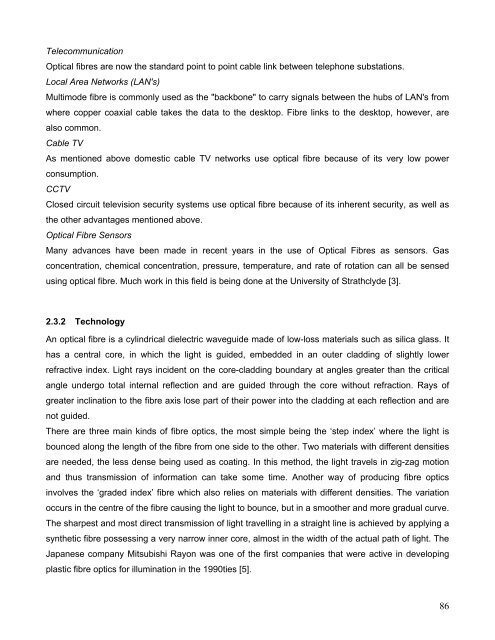Clevertex - Grado Zero Espace Srl
Clevertex - Grado Zero Espace Srl
Clevertex - Grado Zero Espace Srl
Create successful ePaper yourself
Turn your PDF publications into a flip-book with our unique Google optimized e-Paper software.
Telecommunication<br />
Optical fibres are now the standard point to point cable link between telephone substations.<br />
Local Area Networks (LAN's)<br />
Multimode fibre is commonly used as the "backbone" to carry signals between the hubs of LAN's from<br />
where copper coaxial cable takes the data to the desktop. Fibre links to the desktop, however, are<br />
also common.<br />
Cable TV<br />
As mentioned above domestic cable TV networks use optical fibre because of its very low power<br />
consumption.<br />
CCTV<br />
Closed circuit television security systems use optical fibre because of its inherent security, as well as<br />
the other advantages mentioned above.<br />
Optical Fibre Sensors<br />
Many advances have been made in recent years in the use of Optical Fibres as sensors. Gas<br />
concentration, chemical concentration, pressure, temperature, and rate of rotation can all be sensed<br />
using optical fibre. Much work in this field is being done at the University of Strathclyde [3].<br />
2.3.2 Technology<br />
An optical fibre is a cylindrical dielectric waveguide made of low-loss materials such as silica glass. It<br />
has a central core, in which the light is guided, embedded in an outer cladding of slightly lower<br />
refractive index. Light rays incident on the core-cladding boundary at angles greater than the critical<br />
angle undergo total internal reflection and are guided through the core without refraction. Rays of<br />
greater inclination to the fibre axis lose part of their power into the cladding at each reflection and are<br />
not guided.<br />
There are three main kinds of fibre optics, the most simple being the ‘step index’ where the light is<br />
bounced along the length of the fibre from one side to the other. Two materials with different densities<br />
are needed, the less dense being used as coating. In this method, the light travels in zig-zag motion<br />
and thus transmission of information can take some time. Another way of producing fibre optics<br />
involves the ‘graded index’ fibre which also relies on materials with different densities. The variation<br />
occurs in the centre of the fibre causing the light to bounce, but in a smoother and more gradual curve.<br />
The sharpest and most direct transmission of light travelling in a straight line is achieved by applying a<br />
synthetic fibre possessing a very narrow inner core, almost in the width of the actual path of light. The<br />
Japanese company Mitsubishi Rayon was one of the first companies that were active in developing<br />
plastic fibre optics for illumination in the 1990ties [5].<br />
86

















